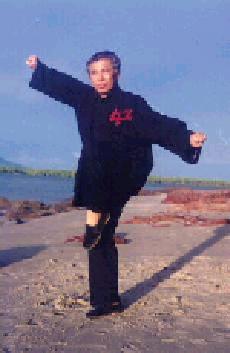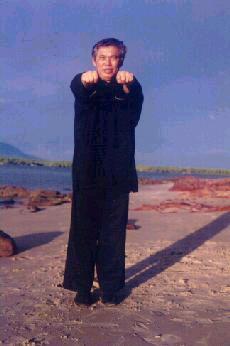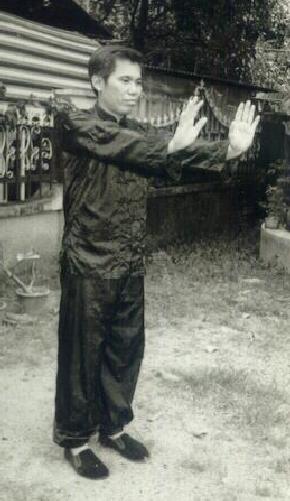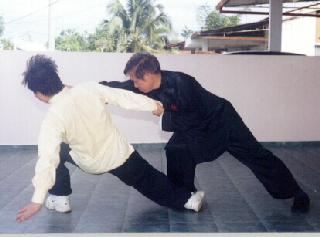January 2001 (Part 3)
SELECTION OF QUESTIONS AND ANSWERS


Although these two principal versions of Shaolin Kungfu, Northern Shaolin (left) and Southern Shaolin (right) have many features in common, they are also characteristically different.
Question 1
I spent a couple of years training in martial arts with a teacher who has survived and won many dangerous street fights. When he was very young, he studied many traditional martial art styles, but he became very disillusioned.
A very important principle of his present fighting style is simple and brutal attacks. For example, an opening move he taught me was a jab to the face, followed by a “shoot throw”. You lunge forward, slam your shoulder into the opponent's stomach, and simultaneously pull his knees up and forward.
— Sage, USA
Answer
Because traditional martial arts, especially kungfu, have been so badly taught that nowadays it is no surprise many people become disappointed and doubt whether they are really effective for combat. Strictly speaking what are commonly taught today are not traditional martial arts but martial sports and gymnastics.
Secondly, there are different reasons for practising martial arts or martial gymnastics. If the reason is only for fighting and nothing else, then your teacher is right, and a jab to the eyes and the shoot throw are effective techniques.
Many people practise martial sports and gymnastics not just for fighting. They also want to have some vigorous exercise, let off steam and to socialize.
If we have the opportunity to practise genuine Shaolin Kungfu or genuine Taijiquan, we can have all these benefits and more. But of course genuine Shaolin Kungfu and genuine Taijiquan are very rare today, and even if one has the opportunity he may not have the required discipline, patience and determination.
Many people think that they can be proficient in Shaolin Kungfu and Taijiquan by merely learning from books, videos or webpages, and in much shorter time and with less effort than what the masters themselves put in. Anyone with some common sense will know that if any art is as great as it is reputed to be, learning it from a video and practising it of and on for a few months cannot make one into a master and then enable him to teach others. Yet many people cherish this illusion.
If your purpose for practising a traditional martial art is for personal development besides self defence, then the palm jab and “shoot throw”, or any brutal techniques, are a very bad choice. Even before you have a chance to try the brutal techniques on any victims, you harm yourself first!
One normally tenses his muscles and contorts his face when training or applying brutal techniques. This causes energy blockage which will be detrimental to his health. More significantly, the habitual thought of and preparation for blinding an opponent at the first instant of combat, and paralysing him at the next, is injurious to the student's psyche, and has subtle but sure repercussions in all aspects of his daily life.
In Shaolin Kungfu and Taijiquan, we are kind even to our opponents. In combat, as we use internal force and not mechanical strength, we apply our skills and techniques in a relaxed and flowing manner. The relaxation and flow of energy, made habitual through daily practice, open the heart as well as other meridians, making the student happy, healthy and fit.
Great masters have always taught that goodness begets goodness, and evil begets evil. This is a most simple and most profound tenet in all religious or spiritual teachings. Because many people do not understand its profundity, they think the teaching is based on superstition. The above is an example of this teaching. The student who harbours hatred towards others harms himself, whereas the one who is kind derives benefits, not because they are punished or rewarded by the Buddha or God, but as a result of their own thoughts and doing.
Question 2
Is there any real defense against such quick and brutal moves? Theoretically, there are many devastating counters against a “shoot throw”, but it seems that in reality it would be difficult to apply them after getting an eye poked, or getting hit in the groin or face.
Do you know of any way those simple, direct, and brutal attacks can be effectively defended against? Or are such moves essentially too quick to be reliably defended against?
Answer
A simple and effective way to defend against the brutal palm jab is to step slightly to your right side with your right leg, instantly move your left leg forward and into your opponent, and push him with your both hands to fell him diagonally backward. This pattern is known in Shaolin Kungfu as “Fierce Tigers Push Mountain”.
Another simple technique is to move a small step diagonally backward with one leg to avoid the palm jab, and simultaneously with the other foot stamp on a side of the opponent's knee. If you stamp hard you may dislocate his knee. This pattern is known as “White Crane Steps on Snow”.
A third technique is to move back your right leg into a left bow-arrow stance if he jabs you with his right palm, and vice versa. This will avoid this palm jab. Simultaneously grip his right wrist with your right hand, pull it straight and press down on his right elbow with your left palm, turning your body rightwards into a bow-arrow stance. This pattern is called “Lohan Tames Tiger”. If you press hard with your left palm you may dislocate his right elbow.
Now, if you are too slow to apply the above techniques and he has grabbed your two legs for a shoot throw, lean forward onto his left shoulder, grab your left arm around his neck, and jab your right palm into his left ribs. This pattern is called “Naughty Monkey Plucks Plums”. You would not fall even though both your legs may be off the ground because you are hanging onto his neck. The sharp pain inflicted by your palm jab would cause him to release his hold on your legs. Stand on one leg and lift one knee to strike him, using the pattern “Golden Cockerel Stands Alone”.
It is important to note that techniques, or “fa” in Chinese, form only one part of any combat. More important are skills, force and speed, collectively known as “kung”.
There is no such a thing as an undefendable attack. Some people may lose a fight because they do not know how to defend against their opponents' attacks. They are the “out-group”, i..e. untrained in genuine martial arts — although they may have practised martial sports or gymnastics for years. They lose on “fa” or techniques.
Those in the “in-group”, i.e. trained in genuine martial arts, know counter techniques for every attack. This does not mean they can't lose. Why do they lose if they know the counters? The answer is that they fail to effectively apply the counters, even though they know them. Usually it is because they are slower, less forceful or less skilful than their opponents. In other words, they lose on “kung”.
Genuine kungfu, including Taijiquan, places great emphasis on “kung”. While students of other martial systems rush into free sparring, which today often means a free exchange of blows and kicks, genuine kungfu students spend much time on “kung” development in such exercises like stance training, breath control and meditation.
Hence, while the fast, brutal moves you described may overwhelm students of modernized martial sports and gymnastics because they have neither “fa” nor “kung” for effective counter, applying those moves to genuine kungfu students who have both “fa” and “kung”, is asking for trouble. The attacker blatantly ignores a fundamental principle of combat, i.e. always make room for a safe retreat. In his haste to attack, the attacker unbelievably ignores his own safety.
When the attacker bends forward to grab the defender's legs, all the defender needs to do to maim or even kill the attacker is to move one leg back into a bow-arrow stance and simultaneously drive a punch into the attacker's head. Even if the attacker has initially poked his palm jab into the defender's eye and has grabbed the defender's legs, in close quarter and with the attacker's two hands indisposed, fighting for life or vengeance the defender could easily tear out the attacker's throat. Although a Shaolin disciple would not use such drastic, destructive counters, he always makes sure his opponent has no chance to use these counters on him.

One of the twelve patterns in Shaolin Sinew Metamorphosis. This powerful Shaolin chi kung exercise looks easy to perform, but students attempting it without proper supervision are likely to harm themselves.
Question 3
Sifu, you have told me before to follow the Shaolin training in your book. How much time should I practice each day (how long for stance training, for chi kung, etc.) Also, what order should I practice them in? Chi Kung, such as Lifting the Sky, before or after stance training, etc.
— Kevin, United States
Answer
I asked you to learn from my books because you could not learn from me personally. There is some very big difference between leaning from me personally, especially in a small group like my intensive course, and learning from my books. This is not because I teach more in my intensive courses than in my books; in fact the information you can get from my books is more than what you get from my intensive courses.
But the essential skills which enable your progress to be exponential (instead of merely arithmetical) can only be transmitted directly from me to you from heart to heart (or mind to mind).
For example, virtually everyone who has attended my intensive courses, can tap energy from the cosmos and generate an internal energy flow within three days. If you learn from my books (which also contain the same techniques involved) you will be very lucky if you can achieve those skills in six months.
Take stance training for another example. Those who have attended my intensive courses, know from their direct experience the purpose and meaning of stance training. In the very first day of their training, they could feel energy surging inside them, and building into a ball at their dan tian. When you learn from my books, you would be lucky to have such an effect in six months.
Most people, including instructors who teach modernized kungfu, would never have this effect because they would have given up after two weeks. Then in their ignorance they might think past masters had kept some secrets and such skills like building a ball of energy and generating energy flow are now only a myth. The crucial point is that they were unwilling to make the essential sacrifice to learn from a master, and some even thought they could learn faster from books and videos.
The questions you asked, like how much time for each practice and in what order, are typical of those who learn from books and those who study rather than train kungfu. Interestingly, those who have attended my intensive courses would not ask those questions. Why? In practical terms, they already know experientially (not intellectually) what and how to do. In philosophical terms, they have liberated themselves from the bondage of unnecessary intellectualization.
An analogy would make this point clearer. A professional footballer would not ask his coach how much time he should spend to practise dribbling and shooting at goal, and which should come first. But a football fan would be interested in these questions as well as such questions like how many times his favourite football star goes to movies, and what types of wine he drinks.
Nevertheless, I would answer you questions. You can spend half an hour or three hours. You can practise chi kung before stance training, or after, or at the same time. The answers are straight forward; there is no play of words.
Whether you should practise for half an hour or three hours, and whether you should perform “Lifting the Sky” first or last, depend on variables like the time available for training, the purpose and quality of training, and your ability and developmental stage.
Question 4
In force training, how should one progress. You include One Finger Zen, Sinew Metamorphosis, Golden Bridge, and Cosmos Palm. Which should be practiced first, or are they all practiced simultaneously?
Answer
Depending on different variables, these questions will have different answers. Generally, you should train one art at one time, but there may be situations when all these arts are practised simultaneously.
In your present situation it is best not to attempt any of these advanced arts. Without proper supervision, it is likely you will harm yourself. Even in the unlikelihood that you can practise any one of these arts correctly on your own, you would have to spend much time to derive little effect.
It is more cost-effective for you to practise basic exercises like stance training, leg stretching, Thirty Punches, Hundred Kicks, fundamental Shaolin patterns and the attack-defence set. If you wish to do force training, you may attempt Golden Bridge, but you must do so cautiously.
Question 5
In the Art of 30 punches, do you just move the arm out, gradually getting faster? Or do you twist your waist and pull the opposite arm back to gain momentum, as in a karate reverse punch? Do you breathe out as the arm punches?
Answer
Don't intellectualize the punch, just do it. Just like when you walk, don't worry whether your left heel or left toes or the whole left foot should be on the ground when you move forward your right leg. Just walk.
If you perform one punch in one breathe, breathe out as you punch. If you perform three punches in one breath, breathe out at the third punch. Don't worry about your breath while doing the first and second punches — just punch.
Question 6
When you mention a “shsss” from the kidneys, a “her-it” sound from the abdomen, and a “yaaa” from the lungs, do these organs actually make the noise, or do you just place your mind at these organs as you make these noises?
Answer
Don't worry whether the respective organs, or the chi in the organs, or the tissues in the organs, or other organs, or your mind make the sounds. You just make the right sounds, which may not be easy to learn from a book. Twenty people learning from the same book may make “shsss” in twenty different ways.

An old picture showing Sifu Wong performing “Pushing Mountain”
Question 7
I've heard many martial artists say that there is no actual style called Shaolin Kung Fu. They say that the name Shaolin refers to just the temple, and that Hung Gar, Praying Mantis, White Crane, etc. are the “styles”. In other words, “Shaolin” is like the tree, with the styles being all the different branches.
Answer
These martial artists are mistaken. The term “Shaolin Kungfu” is the most mentioned of all kungfu styles in the literature of Chinese martial arts. Throughout Chinese martial art history, the number of martial art exponents who said they practised Shaolin Kungfu was far more than those of other kungfu styles.
Chinese expressions like “Shaolin Kungfu is the best under heaven”, “All martial arts originated from Shaolin”, and “Of all kungfu styles in the world, Shaolin Kungfu is the number one” have been well known since classical times.
Hung Gar, Praying Mantis, and White Crane are some of the styles developed from Shaolin Kungfu.
Nevertheless, to define what Shaolin Kungfu is, is not as straight-forward as many kungfu readers (as distinct from practitioners) would like it to be. While few people would dispute a definition like “Shaolin Kungfu is the style of martial art developed from the Shaolin Monastery”, many would argue over its interpretation.
For example, the development of Taijiquan can be traced back to the Shaolin Monastery. Could we, then, argue that Taijiquan is Shaolin Kungfu? On the other hand, some instructors teach karate-like martial arts, but claim their arts were developed from the Shaolin Monastery, which could be true, at least for some of their techniques. Some of these instructors call their arts Shaolin-do, but it is very different from what Shaolin Kungfu is generally conceptualized to be.
Because of its long history, there are actually many versions of genuine Shaolin Kungfu. The kind of kungfu taught in the Shaolin Monastery during the Tang Dynasty, for example, would be very different from the kind taught many centuries later during the Qing Dynasty. Even during the same period, the kind of Shaolin Kungfu taught in north China could be very different from the kind taught in the south.
When exponents of different versions insist that theirs is Shaolin Kungfu, some people would be confused, especially among those who think that when x is a, it cannot be b. Hence, some martial artists mistakenly think there is no such a style as Shaolin Kungfu, but only Shaolin styles like Hung Gar, Praying Mantis and White Crane. It is like saying there is no such a language as English, but only the British language, the American language and the Australian language
Question 8
After the monks learned the 18 Hands of Lohan and Sinew Metamorphosis, who introduced these into kung fu? Did you have to be a monk to live at the temple and learn?
Answer
The Shaolin Monastery was the imperial temple for emperors of all the dynasties since its foundation. Interestingly not many people know this fact.
Among the Shaolin monks were retired ministers and generals. These retired generals evolved Eighteen Lohan Hands, which is a set of eighteen chi kung patterns, into a kungfu set called Shaolin Eighteen Lohan Kungfu Set. They also developed many internal force training methods, such as Golden Bridge and Golden Bell, from Sinew Metamorphosis, which is a set of twelve chi kung exercises.
One had to be a monk to live and learn in the Shaolin Monastery. But at various times, secular disciples were accepted. Among the best known secular disciples living and learning in the Southern Shaolin Monastery were the secular disciples of the Venerable Chi Seen, the First Patriarch of Southern Shaolin Kungfu. Some of them were Hoong Hei Khoon, Fong Sai Yoke and Lok Ah Choy. Another famous secular Shaolin disciple living and learn in the Northern Shaolin Monastery was Wang Lang, the founder of Praying Mantis Kungfu.
Question 9
Lately I have been practicing “Lifting the Sky” daily, and have gained weight and developed a certain amount of muscle in my arms and torso. However, I realise that this is definitely a bonus rather than the ultimate objective: I am not sure that I am performing the exercise on any level greater than the purely physical. I have felt little tingling in the hands, for instance.
— Alexis, Canada
Answer
Judging from your description, it appears that you have performed “Lifting the Sky” incorrectly. Even if you have performed wrongly, you may still get some tingling in your hands.

To be totally relaxed is an essential factor in all chi kung training. When one is proficient, he can, actually should, be totally relaxed in combat too. In the picture above, Sifu Wong could release himself from a dificult neck lock by Goh Kok Hin because he is totally relaxed when applying a right technique with internal force.
Question 10
How ought I find the balance between relaxation and muscular work while performing “Lifting the Sky”? For instance, after about twenty repetitions my arms feel quite fatigued, and may even shake a little. Also, in order to keep my hands flat and facing each other, I must apply a certain degree of purely muscular force.
Answer
If you perform the exercise correctly, you should not feel fatigued, even after a hundred repetitions. There is no need to find balance between relaxation and muscular work. Neither relaxation nor muscular strength is the main objective of any chi kung exercise (although the practitioner is happily relaxed after the exercise).
Relaxation is a pre-requisite, which means if you are not relaxed you cannot do chi kung; you only perform external chi kung forms. And in any chi kung exercise, you avoid muscular work.
The shaking was probably due to your muscles becoming tired. If your hands are not flexible enough, you may have to apply some “force”, but you do not “force” it.
This statement may appear self-contradictory. The apparent contradiction is due to the limitation of words to express finer or deeper shades of meaning. In the statement above, the first “force” is different from the second “force”. You can only know the difference by learning directly from a competent teacher.
Question 11
I fear that I use too much force generally, yet find it almost impossible to maintain relaxation throughout. .
Answer
A basic requirement for practising chi kung correctly is to maintain relaxation throughout. If you can't do this, it is probable that you have not been practising correctly.
Force is used in certain types of chi kung, such as in “fa Jing”, or exploding force to strike an opponent, but the exponent does not force himself. Here the first “force” is effected by directing energy flow, but is different from the “force” you use to bend your palms so that they are at right angles to your arms in “Lifting the Sky”, and is totally different from forcing yourself by tensing your muscles. These three different types of force are characteristically different, but in English there is only one word, “force” to describe these three different situations.
Hence, many people are confused. For example, when a master says that in applying internal force, one should not use force, they become confused because they think that “force” mentioned in the first instant is the same as “force” in the second instant. They mistakenly read the statement as “when applying x do not use x”. What the master means is that when applying internal force one should not tense his muscles, which is “when apply x do not use y”.
This is one of many examples illustrating that if you wish to learn chi kung, which involves using force, you should learn from a living teacher and not from a book or a video. Some people do not even know what is “not tensing your muscles”, although they know its dictionary meaning.
Question 12
In “The Art of Chi Kung” you mention breathing in as the hands rise. Should I inhale once only? I refer of course to my normal, relatively shallow breathing. I certainly have not mastered the slow, deep Shaolin breathing technique.
Answer
Yes, inhale once only as you raise your hands in “Lifting the Sky”. Use just one breath for one repetition, 5 breaths for 5 repetitions, and x breaths for x repetitions. In this exercise, the structure of the breath is as follows: pause, breathe in, pause, breathe out.
This instruction on the breathing pattern is straight-forward enough, yet you can safely bet that out of ten persons who attempt this exercise by reading my book, at least seven will not perform the breathing as described. For example, they may use 8 breaths for 5 repetitions. Luckily, this “mistake” is not serious, and by itself will not have any harmful effects.
But the progress can be vastly different. Just basing on this point alone, your breathing may still be fast and shallow after a year of training, whereas a student training with a master may have slow, deep breathing after three months. Why? Because that student uses the exercise to train his breathing, whereas you merely breathe to do the exercise. It is not without good reasons I have often emphasized that if one wishes to have good result in chi kung, he should learn from a master.
